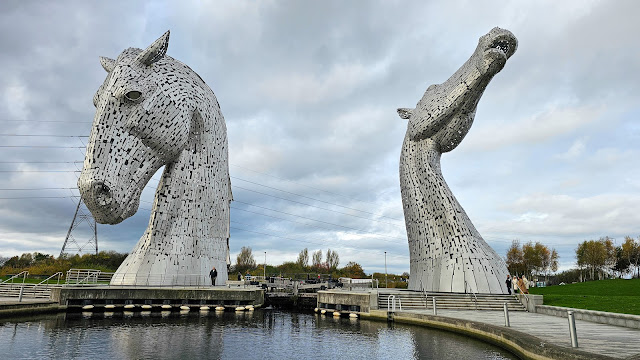Crieff Hydro Hotel to Glenturret Distillery to the Kelpies, to Dunfermline to Edinburgh-Scottish Isles and Glens
Today we're going to see the Kelpies!
Our brief, overnight stay at the Crieff Hydro Hotel is over. By far THE nicest hotel we've stayed in on this trip. It sits on a beautiful property and the rooms are off-the-charts comfy.
Our Guide Graham, ready for our next adventure.
They claim to be the oldest distillery in Scotland; a rental document from the Murray family is dated back to 1763 helping to support this claim. In 2019, Glenturret was purchased by Lalique.
After a tour by our very enthusiastic guide, we get to the tasting. Photos are not allowed during the tour, they say because of the fumes and possible fires. But I've photographed many a distillery, I think it's to keep trade secrets, a secret.
The distillery even has a monument to their best mouser of a cat, Towser, who is in the Guinness Book of record by the way!
With our heads spinning from the fumes and drink and shopping, we're back on the bus and heading to Falkirk. Along the way we pass through Stirling and can see both the William Wallace Monument and Stirling Castle from the coach.
If you've ever watched the movie BRAVEHEART, then you know who William Wallace was.
Sir William Wallace was a Scottish knight who became one of the main leaders during the First War of Scottish Independence.
Along with Andrew Moray, Wallace defeated an English army at the Battle of Stirling Bridge in September 1297. He was appointed Guardian of Scotland and served until his defeat at the Battle of Falkirk in July 1298.
In August 1305, Wallace was captured in Robroyston, near Glasgow, and handed over to King Edward I of England, who had him hanged, drawn and quartered for high treason and crimes against English civilians.
And speaking of Falkirk, on our last trip to Scotland, while in Falkirk Jay and I visited the Falkirk Wheel an engineering wonder. But we have no time on this trip, because we're going to see the Kelpies!!
The Helix Park: Home of the Kelpies. The Kelpies, we've driven by a couple of times but never actually stopped to see them up close and personal. They are the largest equine sculpture in the world and they are magnificent!
Our crew from the US and Canada.
The kelpie is usually described as a powerful and beautiful black horse inhabiting the deep pools of rivers and streams of Scotland, preying on any humans it encounters.
One of the water-kelpie's common identifying characteristics is that its hooves are reversed as compared to those of a normal horse, a trait also shared by the nykur of Iceland.
An Aberdeenshire variation portrays the kelpie as a horse with a mane of serpents, whereas the resident equine spirit of the River Spey was white and could entice victims onto its back by singing.
All this horsing around has gotten us pretty hungry, so we head into Dunfermline to grab a bite to eat. Jay and I have lunch at JD Wethersppons- pizza and beer 11 pounds!! And their bathroom! Oh My
We walk off those calories by exploring the Dunfermline Abbey.
Dunfermline Abbey is a Church of Scotland parish church that occupies the site of the ancient chancel and transepts of a large medieval Benedictine abbey, which was confiscated and sacked in 1560 during the Scottish Reformation and permitted to fall into disrepair.
Robert the Bruce was buried, in 1329, in the choir, now the site of the present parish church. Bruce's heart rests in Melrose Abbey, but his bones lie in Dunfermline Abbey, where (after the discovery of the skeleton in 1818) they were reinterred with fitting pomp below the pulpit of the New church. In 1891, the pulpit was moved back and a monumental brass inserted in the floor to indicate the royal vault.
Jay and I saw the "heart" in 2017. When we visited Melrose Abbey.
As the sun is setting we make stop on the Forth for a few Bridge photos.
Then we head our way into Edinburgh for our evening of a Scottish Welcome Dinner.
The next two days will be spent wandering around Edinburgh.
































